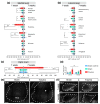Traumatic Brain Injury Promotes Neurogenesis and Oligodendrogenesis in Subcortical Brain Regions of Mice
- PMID: 39851520
- PMCID: PMC11764027
- DOI: 10.3390/cells14020092
Traumatic Brain Injury Promotes Neurogenesis and Oligodendrogenesis in Subcortical Brain Regions of Mice
Abstract
Traumatic brain injury (TBI) is one of the major causes of severe neurological disorders and long-term dysfunction in the nervous system. Besides inducing neurodegeneration, TBI alters stem cell activity and neurogenesis within primary neurogenic niches. However, the fate of dividing cells in other brain regions remains unclear despite offering potential targets for therapeutic intervention. Here, we investigated cell division and differentiation in non-neurogenic brain regions during the acute and delayed phases of TBI-induced neurodegeneration. We subjected mice to lateral fluid percussion injury (LFPI) to model TBI and analyzed them 1 or 7 weeks later. To assess cellular proliferation and differentiation, we administered 5-ethinyl-2'-deoxyuridine (EdU) and determined the number and identity of dividing cells 2 h later using markers of neuronal precursors and astro-, micro-, and oligodendroglia. Our results demonstrated a significant proliferative response in several brain regions at one week post-injury that notably diminished by seven weeks, except in the optic tract. In addition to active astro- and microgliosis, we detected oligodendrogenesis in the striatum and optic tract. Furthermore, we observed trauma-induced neurogenesis in the striatum. These findings suggest that subcortical structures, particularly the striatum and optic tract, may possess a potential for self-repair through neuronal regeneration and axon remyelination.
Keywords: adult neurogenesis; brain trauma; cell proliferation; fluid percussion injury; gliosis; oligonendrogenesis; optic tract; striatum; substantia nigra; thalamus.
Conflict of interest statement
The authors declare no conflicts of interest. The funders had no role in the design of the study; in the collection, analyses, or interpretation of data; in the writing of the manuscript; or in the decision to publish the results.
Figures







Similar articles
-
A-kinase anchor protein 12 promotes oligodendrogenesis and cognitive recovery in carbon monoxide therapy for traumatic brain injury.J Cereb Blood Flow Metab. 2025 Jun;45(6):1180-1190. doi: 10.1177/0271678X251314371. Epub 2025 Jan 25. J Cereb Blood Flow Metab. 2025. PMID: 39862180 Free PMC article.
-
Enhancing neurogenesis after traumatic brain injury: The role of adenosine kinase inhibition in promoting neuronal survival and differentiation.Exp Neurol. 2024 Nov;381:114930. doi: 10.1016/j.expneurol.2024.114930. Epub 2024 Aug 21. Exp Neurol. 2024. PMID: 39173898 Free PMC article.
-
Repetitive and Prolonged Omega-3 Fatty Acid Treatment After Traumatic Brain Injury Enhances Long-Term Tissue Restoration and Cognitive Recovery.Cell Transplant. 2017 Apr 13;26(4):555-569. doi: 10.3727/096368916X693842. Epub 2016 Nov 24. Cell Transplant. 2017. PMID: 27938482 Free PMC article.
-
Stem Cell Therapy in Brain Trauma: Implications for Repair and Regeneration of Injured Brain in Experimental TBI Models.In: Kobeissy FH, editor. Brain Neurotrauma: Molecular, Neuropsychological, and Rehabilitation Aspects. Boca Raton (FL): CRC Press/Taylor & Francis; 2015. Chapter 42. In: Kobeissy FH, editor. Brain Neurotrauma: Molecular, Neuropsychological, and Rehabilitation Aspects. Boca Raton (FL): CRC Press/Taylor & Francis; 2015. Chapter 42. PMID: 26269908 Free Books & Documents. Review.
-
Myelin and oligodendrocyte lineage cells in white matter pathology and plasticity after traumatic brain injury.Neuropharmacology. 2016 Nov;110(Pt B):654-659. doi: 10.1016/j.neuropharm.2015.04.029. Epub 2015 May 9. Neuropharmacology. 2016. PMID: 25963414 Review.
Cited by
-
Advances in research on biomaterials and stem cell/exosome-based strategies in the treatment of traumatic brain injury.Acta Pharm Sin B. 2025 Jul;15(7):3511-3544. doi: 10.1016/j.apsb.2025.05.010. Epub 2025 May 21. Acta Pharm Sin B. 2025. PMID: 40698148 Free PMC article. Review.
References
-
- Maas A.I.R., Menon D.K., Adelson P.D., Andelic N., Bell M.J., Belli A., Bragge P., Brazinova A., Büki A., Chesnut R.M., et al. Traumatic Brain Injury: Integrated Approaches to Improve Prevention, Clinical Care, and Research. Lancet Neurol. 2017;16:987–1048. doi: 10.1016/S1474-4422(17)30371-X. - DOI - PubMed
Publication types
MeSH terms
Grants and funding
LinkOut - more resources
Full Text Sources
Medical

